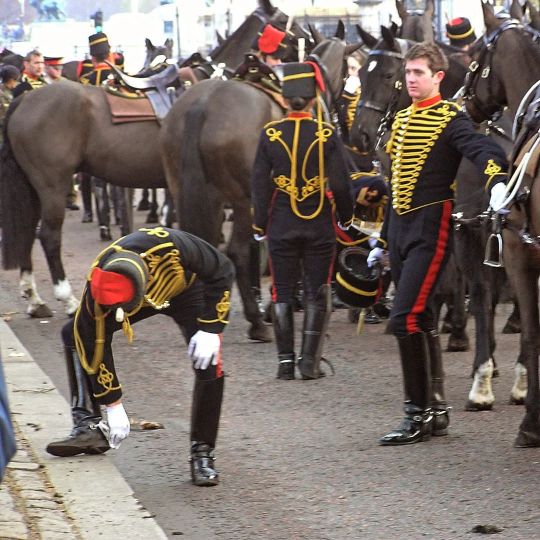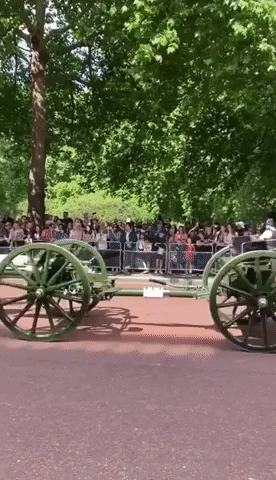#king's troop royal horse artillery
Photo

Si post fata venit gloria, non propero.**
- Martial
The origins of the King’s Troop, Royal Horse Artillery can be traced back to the formation of the Royal Horse Artillery in 1793 when Captain Quist (a graduate of the Spanish Riding School of Vienna) was tasked with training both horses and gunners to support the Royal Artillery Regiment. Captain Quist clearly loved his job and continued in his post until his death in 1821, aged 91.
Between the First and Second World Wars, all the horses were sold when, in line with the entire British Army, the Horse Artillery was mechanised. But following the Second World War, at the request of King George VI, a saluting battery ‘dressed and equipped in traditional style’ was formed under the command of Lt Col Gillson. This would be the King’s Troop. Their first salute was fired in celebration of the King’s birthday on 24 October 1947 and following his inspection of his newly-formed riding troop, the King announced that he wished it to be known as the King’s Troop, a wish graciously supported and continued by his daughter when she became Queen, in recognition of her father’s special interest in the Troop.
Today the Troop’s duties include the firing of Royal Salutes on Royal anniversaries and State occasions, participation in Armistice Day parades, the Lord Mayor’s Show and the King’s birthday parade. As part of the Household Troops, the Troop also performs the duties of the King’s’s Life Guard at Horse Guards for one month each year. Perhaps the most famous of the Troop’s duties is the provision of the gun carriage and team of black horses for State and Military funerals.
Of the 154 soldiers in the unit, very nearly half are female, an unusually high percentage for the British Army since women were allowed to apply in 1996. Between them, they look after 120 horses. At the moment, The King's Troop boasts the Army's first ever female Master Tailor, Sgt Emma Colton. The colourful uniform itself is a work of art and more a piece of armour than the glamorous black, gold and red kit it presents as. Lined in pigskin, it is constructed to protect its wearer from sword strikes. The gold brocade protects the chest, the buttons emulate musket balls, while the raised collars prevent penetration of lethal slashes to the neck or throat. There are a huge number of uniform combinations for the King’s Troop, some as subtle as a change of tie. An average day will require four or five changes; for officers this could be as many as 12.
The great attraction of the unit is of course the chance to work with horses. The soldiers not only ride them on ceremonial duties, they also get the chance to compete. Soldiers from the unit have done very well in world wide competitions in show jumping and dressage.
**If glory comes after death, I hurry not.
#king's troop royal horse artillery#king's troop RHA#martial#latin#classical#british army#horses#horse riding#royal horse artillery#britain
50 notes
·
View notes
Photo
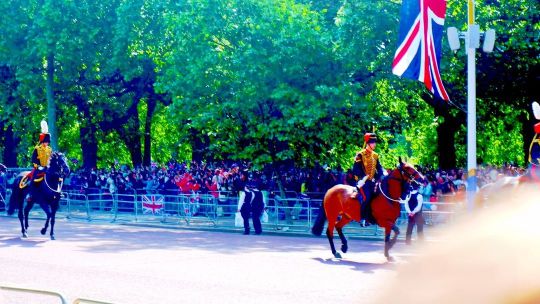
Following the mechanisation of artillery 2nd World War, King George VI expressed the view that a unit should be created to provide horse-drawn artillery for state ceremonies, leading to the creation of the King's Troop Royal Horse Artillery, who to this day use 1st World War era QF 13 pounder guns for royal gun salutes in Green Park & Hyde Park. I managed to get a few photos of them moving cannons up to Buckingham Palace for the salute after the Trooping of the Colour, and thought Armed Forces Day would be as good a day as any other to share them. While the day sees much attention given to military personal serving in conflict, and rightly so, it's also worth keeping in mind the important role our armed forces play in state occasions. Not only is the military presence at such occasions an important security measure, but, as the role of units like this show, the ceremonial role of the military expresses the importance of state authority as the co-ordinating force, protecting communities from dangers from within and without the nation's boarders. Gun salutes have long been used as part of military ceremonies to mark major state and military occasions, bringing communities together behind their country and its leadership. https://www.instagram.com/p/CfOkgMIj4B1/?igshid=NGJjMDIxMWI=
#Armed Forces Day#King's Troop#British Army#horse artillery#artillery#millitary#traditionalism#Trooping of the Colour#King's Troop Royal Horse Artillery#Great Britain#military ceremony#millitary tradition#Platinum Jubilee#history
1 note
·
View note
Text
Although the media did not receive confirmation from Kensington Palace, GB News decided Trooping the Colour is Catherine's RETURN to public duties. 🤦♂️
Great Comment to GB News: "so will you all shut up now?" 👏


From Forces.net
Princess of Wales to review Trooping the Colour before main event in June, Army says
Despite the announcement by the Army, Kensington Palace has yet to confirm Kate's attendance at the military spectacle.
Only Kensington Palace, Kate's official office, can announce her attendance at a royal event and confirmation is not expected until nearer the time.
Kate is scheduled to take part in the formal review – known as the Colonel's Review – on 8 June, a week before the main Trooping the Colour, inspecting soldiers of the Household Division in her role as Colonel of the Irish Guards.
The Princess of Wales will review the Trooping the Colour in June, according to the Army's official website, making this her first official duty to be announced since she underwent abdominal surgery in mid-January,
The Army's website says the King will be attending the main Trooping ceremony – also known as the Birthday Parade, as it marks the sovereign's official anniversary – with bookings now being taken for a ballot for tickets.
King Charles is receiving treatment for cancer and Kate is recovering from abdominal surgery, but it is understood planning for major royal events continues, with organisers remaining flexible in the event of possible changes.
Kate officially became Colonel of the Irish Guards, a role previously held by her husband the Prince of Wales, last year.
In January, it was announced the Princess of Wales would miss this year's St Patrick's Day military parades in March as she continued her recovery from surgery.
The Trooping the Colour to be reviewed by the Princess of Wales is identical to the Trooping the Colour reviewed by the King, apart from the fact that some additional mounted officers will take part when the King is present.
According to the Army, more than 1,400 soldiers of the Household Division and The King's Troop Royal Horse Artillery will be taking part, including 400 musicians from the Massed Bands, with all of them parading on Horse Guards for the second of two formal reviews.
The event will also include 250 soldiers from the Foot Guards who will line the processional route along The Mall.
Members of the public can watch from the stands on Horse Guards Parade by applying for tickets.
36 notes
·
View notes
Text

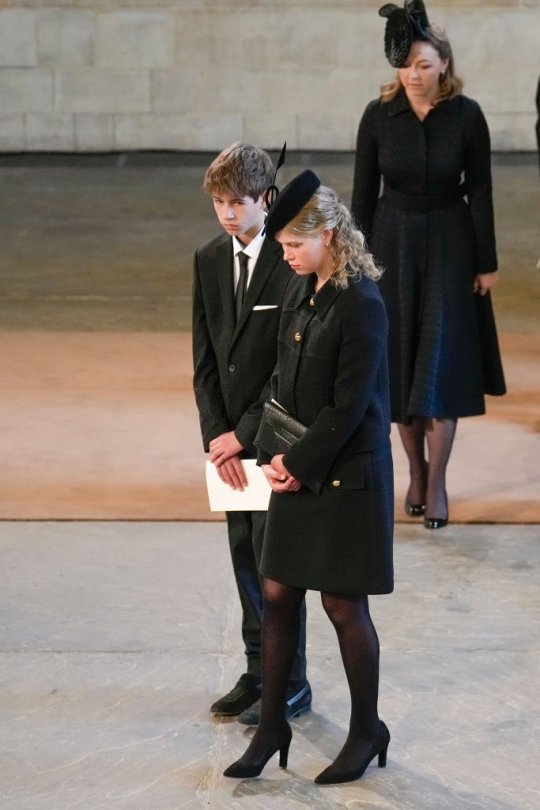

James, Viscount Severn and Lady Louise Windsor pay their respects in The Palace of Westminster after the procession for the Lying-in State of Queen Elizabeth II on September 14, 2022 in London, England. Queen Elizabeth II's coffin is taken in procession on a Gun Carriage of The King's Troop Royal Horse Artillery from Buckingham Palace to Westminster Hall where she will lay in state until the early morning of her funeral.
622 notes
·
View notes
Text

King Charles III and The Prince of Wales salute as the Queen Elizabeth II's coffin is taken in procession on a Gun Carriage of The King's Troop Royal Horse Artillery from Buckingham Palace to Westminster Hall on September 14, 2022 in London.
#british royal family#british royals#brf#british royalty#royals#royalty#royal#14.09.2022#my edit#william wales#prince of wales#william#prince william#king charles iii#king charles#queen elizabeth ii#westminster hall service 22#qeii coffin bp procession
438 notes
·
View notes
Text
Timeline of Remembrance Sunday events at the Cenotaph;
• 10:58 - HM King Charles and Members of The Royal Family will leave the Foreign, Commonwealth and Development Office building and move to a position north of the Cenotaph. A full list of those laying wreaths can be found in List C on pages 16-19. Members of The Royal Family that are viewing the ceremony from the balconies in the Foreign, Commonwealth and Development Office, HM The Queen, HRH The Princess of Wales, HH The Duchess of Edinburgh, Vice Admiral Sir Tim Laurence and TRH The Duke and Duchess of Gloucester will be escorted to their rooms on the first floor.
• 11:00 - On the first stroke of eleven by Big Ben the Two Minutes' Silence commences by the firing of a gun from Horse Guards Parade by The King's Troop Royal Horse Artillery.
• 11:02 - The firing of a gun marks the end of the Silence. The Last Post is sounded by the Buglers of the Royal Marines
• 11:03 - HM King Charles lays a wreath at the Cenotaph. An equerry will lay a wreath on behalf of HM The Queen. The other members of The Royal Family will lay their wreaths as follows. HRH The Prince of Wales, HRH The Duke of Edinburgh, HRH The Princess Royal and HRH The Duke of Kent's wreath will be laid by his equerry.
Laying of Wreaths
HM The King will lay a wreath in the centre of the top step on the north side of the Cenotaph.
The following Members of The Royal Family lay wreaths in succession on the north side of the Cenotaph: -
• HM The Queen laid by Major Ollie Plunket
• HRH The Prince of Wales
• HRH The Duke of Edinburgh
• HRH The Princess Royal
• HRH The Duke of Kent laid by his Equerry Captain George Hopkins
At the Cenotaph this morning. The Princess Royal, accompanied by Vice Admiral Sir Tim Laurence, will take the salute on Horse Guards Parade for the march past of the ex-service and civilian associations following the Remembrance Sunday ceremony.
Information from @majestymagazine / Joe Little
22 notes
·
View notes
Text
The State Funeral of Her Majesty The Queen will take place at Westminster Abbey on Monday 19th September at 1100hrs BST. Prior to the State Funeral, The Queen will Lie-in-State in Westminster Hall for four days, to allow the public to pay their respects.
The Queen's Coffin currently rests in the Ballroom at Balmoral Castle. Her Majesty's Coffin will travel to Edinburgh tomorrow, Sunday 11th September, by road, to arrive at the Palace of Holyroodhouse, where it will rest in the Throne Room until the afternoon of Monday 12th September.
On the afternoon of Monday 12th September, a Procession will be formed on the forecourt of the Palace of Holyroodhouse to convey the Coffin to St Giles' Cathedral, Edinburgh. The King and Members of the Royal Family will take part in the Procession and attend a Service in St Giles’ Cathedral to receive the Coffin.
Her Majesty's Coffin will then lie at rest in St Giles' Cathedral, guarded by Vigils from The Royal Company of Archers, to allow the people of Scotland to pay their respects.
On the afternoon of Tuesday 13th September, The Queen's Coffin will travel from Scotland by Royal Air Force aircraft from Edinburgh Airport, arriving at RAF Northolt later that evening. The Coffin will be accompanied on the journey by The Princess Royal.
The Queen's Coffin will then be conveyed to Buckingham Palace by road, to rest in the Bow Room. On the afternoon of Wednesday 14th September, the Coffin will be borne in Procession on a Gun Carriage of The King’s Troop Royal Horse Artillery from Buckingham Palace to the Palace of Westminster, where The Queen will Lie-in-State in Westminster Hall until the morning of the State Funeral.
The Procession will travel via Queen’s Gardens, The Mall, Horse Guards and Horse Guards Arch, Whitehall, Parliament Street, Parliament Square and New Palace Yard. After the Coffin arrives at Westminster Hall, The Archbishop of Canterbury will conduct a short service assisted by The Very Reverend Dr David Hoyle, Dean of Westminster, and attended by The King and Members of the Royal Family, after which the Lying-in-State will begin.
During the Lying-in-State, members of the public will have the opportunity to visit Westminster Hall to pay their respects to The Queen. On the morning of Monday 19th September, the Lying-in-State will end and the Coffin will be taken in Procession from the Palace of Westminster to Westminster Abbey, where the State Funeral Service will take place.
Following the State Funeral, the Coffin will travel in Procession from Westminster Abbey to Wellington Arch. From Wellington Arch, the Coffin will travel to Windsor and once there, the State Hearse will travel in Procession to St. George’s Chapel, Windsor Castle via the Long Walk. A Committal Service will then take place in St George's Chapel.
191 notes
·
View notes
Video
Queen Elizabeth II leaves Buckingham Palace for the final time.
Her coffin is borne by the Gun Carriage of The King’s Troop Royal Horse Artillery to the Palace of Westminster.
The Imperial State Crown rests on the coffin. -- Royal Central
111 notes
·
View notes
Text
What to expect today:
• At 2.22 pm,the Queen’s coffin will be transported from Buckingham Palace in a ceremonial procession followed by the King and members of the royal family.
• The oak coffin will be taken on a gun carriage of the King’s Troop Royal Horse Artillery to Westminster Hall, where the lying in state will begin.
• Guns will be fired at Hyde Park and Big Ben bell will toll.
• The procession will travel along The Mall, Horse Guards Road, Horse Guards Parade to Parliament Square, with a short service at the Palace of Westminster at 3pm.
• The Queen’s coffin will be rested on a raised platform, called a catafalque, and draped in the Royal Standard with the Orb and Sceptre placed on top.
• Members of the public can pay their respects for 24 hours a day from 5pm on Wednesday until 6.30am on the morning of the funeral.
73 notes
·
View notes
Text
"… he was known as King Marmont"
After the Empire had ended, Charles d’Agoult, now in his mid-twenties, held the rank of colonel – and was left crippled by a serious leg wound he had received during the batlles of the final campaign in 1814. (Ironically, this may have been the only time he actually fought directly under Napoleon’s superior command.) His crippled leg preventing him from most active service, he did remain in the army but now was charged mostly with minor administrative tasks. At some point, he also served under Marshal Marmont, for whom he has much praise in his memoirs.
The Duke of Ragusa was certainly the most maligned man of this century. After the disasters of 1814, a victim was needed. The Jacobins and Bonapartists would not admit to having been defeated. They preferred to cry out that they had been betrayed.
It’s pretty obvious that d’Agoult, an ardent royalist (of the older Bourbon branch at least) would take a friendlier stance towards Marmont, whose actions to some degree had helped to put Louis XVIII on the throne. But that does not render the point he makes above invalid. Marmont’s actions on April 5 (whatever they really were) surely did not have a huge impact anymore. Napoleon had lost the war fair and square, had kept loosing it ever since 1812.
The truth is that Marmont, entrusted with the difficult mission of defending Paris alongside Mortier, abandoned by the ministers and by King Joseph, was the last and most intrepid defender of this great city. We saw him in the streets of Belleville, surrounded by a few foot soldiers, sword in hand, his uniform torn, fighting like a sous-lieutenant and encouraging the soldiers. It was only during the night that he returned home, exhausted with fatigue and hunger.
And for once I feel like I need to defend Joseph: When he ordered the government to leave the capital, he only followed the instructions he had received from Napoleon.
Of all the marshals, Marmont was certainly the most educated and intelligent. The Emperor loved to chat with him. His bravery appealed to the troops. There was grandeur in his ideas and in his manners. In the army, he was known as King Marmont.
While Charles d’Agoult apparently sees this royal bearing as a positive character trait, I highly doubt that in a French army with a mostly republican and anti-royal attitude the nickname "King" was meant in a friendly manner.
He had a mamelouk, superb mules with silver rings and bells, and while others grew rich through shameful embezzlement, he spent his fortune nobly.
This is a highly interesting attitude that imo also says a lot about why the d’Agoults were constantly in debt: Spending money, if you have it or not, is admirable and a true sign of nobility. - As to Marmont’s fortune, it was actually more that of his wife and father-in-law, but that was probably all the same to d’Agoult. As far as the embezzlements are concerned … well, at least Eugène de Beauharnais seems to have had a different opinion at times.
A skilled artillery officer, it was he who came up with the idea of placing the cannons in the hollowed-out fir trees at the Saint-Bernard pass. For a long time, there were guns a la Marmont in the artillery.
The misfortune of this illustrious marshal was that his vivid imagination lacked measure and prudence. He threw himself, so to speak, on an idea, on a speculation. Having been one of the first to guess the considerable role beet would play in industry, he set about spending extravagantly on his beautiful land at Chatillons-sur-Seine, building sugar mills and refineries, not to mention forges and a magnificent stud farm…
Not quite sure how the horses would help with the beet but okay. It’s also this unmeasured imagination that Charles sees at the root of Marmont’s act of disloyalty in 1814.
9 notes
·
View notes
Text

Princess Anne at the lunch of a book on the Kings Troop Royal Horse Artillery, on 17 January 1985.
33 notes
·
View notes
Photo
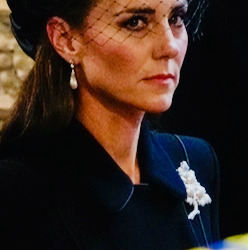
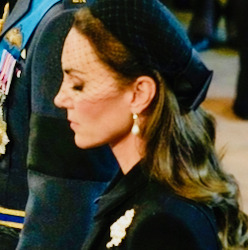
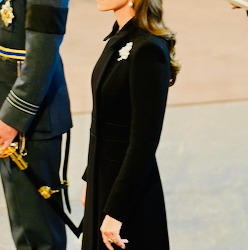
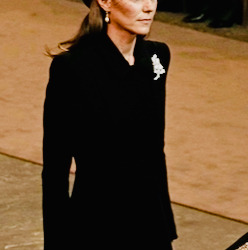
Through the Years → Catherine, Princess of Wales (838/∞)
14 September 2022 | Prince William, Prince of Wales, Catherine, Princess of Wales, Prince Harry, Duke of Sussex and Meghan, Duchess of Sussex seen inside the Palace of Westminster during the Lying-in State of Queen Elizabeth II in London, England. Queen Elizabeth II's coffin is taken in procession on a Gun Carriage of The King's Troop Royal Horse Artillery from Buckingham Palace to Westminster Hall where she will lay in state until the early morning of her funeral. Queen Elizabeth II died at Balmoral Castle in Scotland on September 8, 2022, and is succeeded by her eldest son, King Charles III. (Photo by Gregorio Borgia/Christopher Furlong/Nariman El-Mofty/Getty Images)
#Catherine#Princess of Wales#Britain#2022#Gregorio Borgia#Christopher Furlong#Nariman El Mofty#Getty Images#through the years: Catherine
25 notes
·
View notes
Text

King Charles III, Prince William, Prince of Wales, Princess Anne, Princess Royal, Prince Harry, Prince Andrew, Duke of York, Duke of Gloucester and 2nd Earl of Snowdon salutes the coffin of Queen Elizabeth II, adorned with a Royal Standard and the Imperial State Crown, as it arrives at the Palace of Westminster, following a procession from Buckingham Palace on September 14, 2022 in London, United Kingdom. Queen Elizabeth II's coffin is taken in procession on a Gun Carriage of The King's Troop Royal Horse Artillery from Buckingham Palace to Westminster Hall where she will lay in state until the early morning of her funeral.
#queen elizabeth ii#lying in state#princess anne#princess royal#king charles iii#prince of wales#prince harry#prince edward#prince andrew#duke of gloucester#2nd earl of snowdon
321 notes
·
View notes
Text

16 September 2022

Thousands of people have been queuing along the banks of the River Thames to view the Queen's coffin as she lies in state in London's Westminster Hall.
Queues have been building since Wednesday morning, with hundreds of thousands of people expected to pay their respects before her funeral on Monday.
Lying-in-state begins
A line of mourners hoping to view the coffin is snaking for around five miles from Westminster across Lambeth Bridge and along the river to Southwark Park.
Some have queued for hours, sometimes overnight, in all weathers for a chance to pay their respects.

Westminster Hall opened its doors to the public on Wednesday (September 14) after a grand procession brought the Queen's coffin from Buckingham Palace.
The lying-in-state will continue until 06:30 BST on Monday, the day of the state funeral.
The government has warned people could face 30-hour waits to get in.
They will walk by the Queen's closed coffin, which rests on a raised platform, known as a catafalque, beneath the 11th Century hall's medieval timber roof.

Each corner of the platform is being guarded in a continuous vigil by soldiers from units that serve the Royal Household.
The coffin is draped in the Royal Standard and topped with the Imperial State Crown, a wreath of white roses and dahlias and the Sovereign's orb and sceptre.

The grand hall is the oldest part of the Palace of Westminster, at the heart of British government.
The last member of the Royal Family to lie in state in the hall was the Queen Mother in 2002, when more than 200,000 people queued to view her coffin.
The BBC has a dedicated live stream for those unable to travel to London.
The service is available in the UK on the BBC home page, the BBC News website and app, iPlayer, BBC Parliament and the red-button. It is also available internationally via bbc.com/news.
Slow journey to Westminster Hall
On Wednesday, crowds of mourners packed the streets between Buckingham Palace and Westminster for the slow ceremonial procession to carry the coffin to the hall.
In the bright sunshine that followed the rain, the coffin made its way through the heart of the capital borne on an open gun carriage of the King's Troop Royal Horse Artillery, drawn by seven black horses.
A huge 18 hands-tall (183cm) veteran horse named Lord Firebrand, ridden by Capt. Amy Cooper, led the procession and set the pace.

The gun carriage, known as the George Gun Carriage, carried King George VI's coffin in 1952 and was used in the Queen Mother's funeral in 2002.
To the sound of funeral marches played by the Scots Guards and the Grenadier Guards, the procession stepped off at a slow pace of 75 steps per minute - a tempo typically reserved for such sombre occasions.
King Charles III, wearing full ceremonial uniform, followed behind the coffin on foot, accompanied by his siblings as well as his sons, Prince William, dressed in his Royal Air Force uniform, and Prince Harry in a morning suit.

The sight of the brothers together, walking behind the coffin, evoked poignant memories of their mother Diana's funeral 25 years ago, said royal correspondent Sean Coughlan.
Up to 1,000 members of the armed forces in ceremonial dress took part in events surrounding the parade.
Behind mounted Metropolitan Police, the procession was headed by the Household Cavalry and the Grenadier and Scots Guards.
They were followed, just ahead of the Queen's coffin, by members of the Royal Household, those working closely with the Queen.
Following the King and other royals behind the coffin and bringing up the rear of the procession were members of the King's former household, when he was known as the Prince of Wales.

Guns were being fired from Hyde Park at one-minute intervals throughout the procession. Big Ben also tolled.
As her coffin passed by, some in the crowd burst into tears, BBC correspondent Nick Beake said.
Others made the sign of the cross, army veterans saluted their former commander-in-chief - while families embraced, he added.
25 notes
·
View notes
